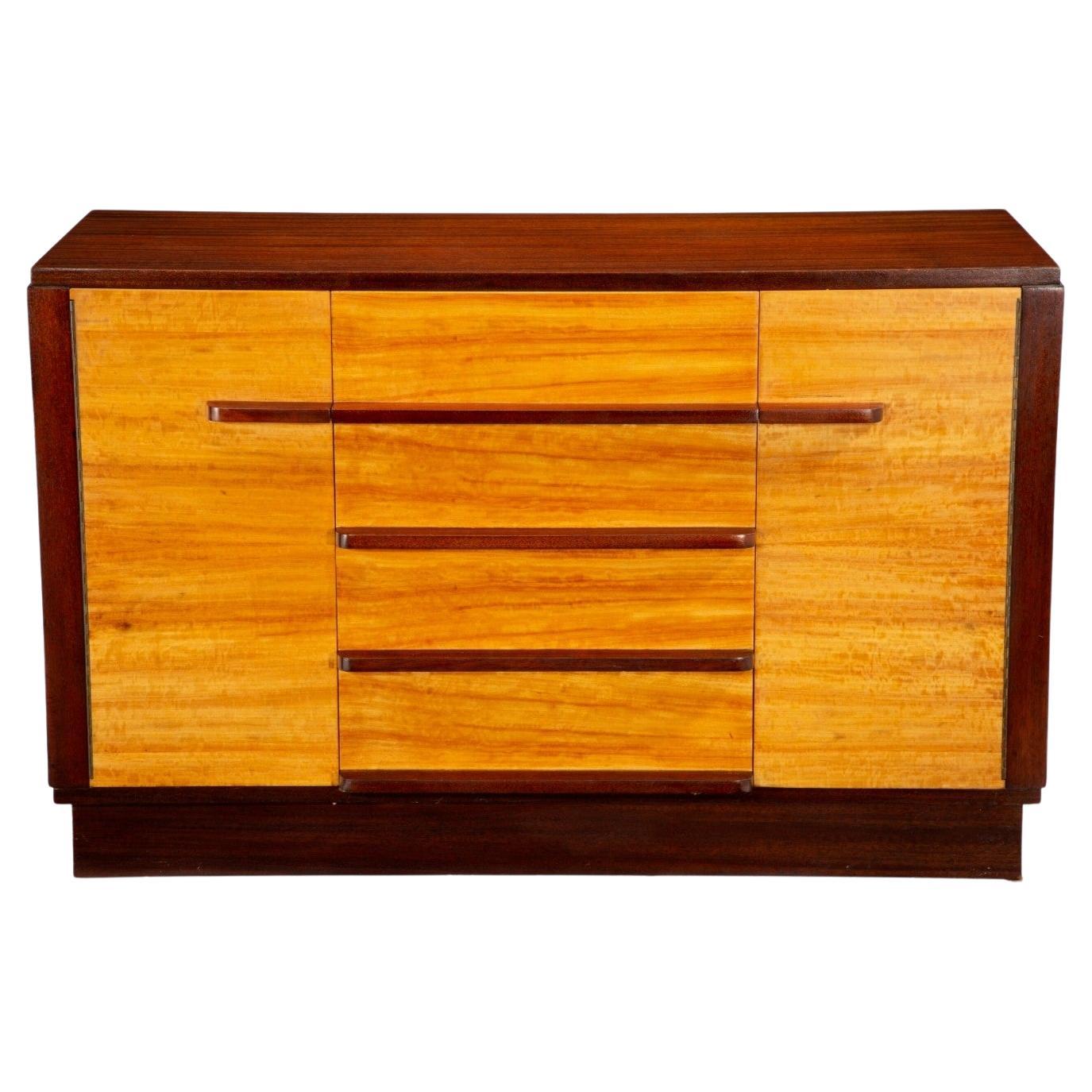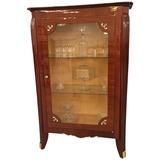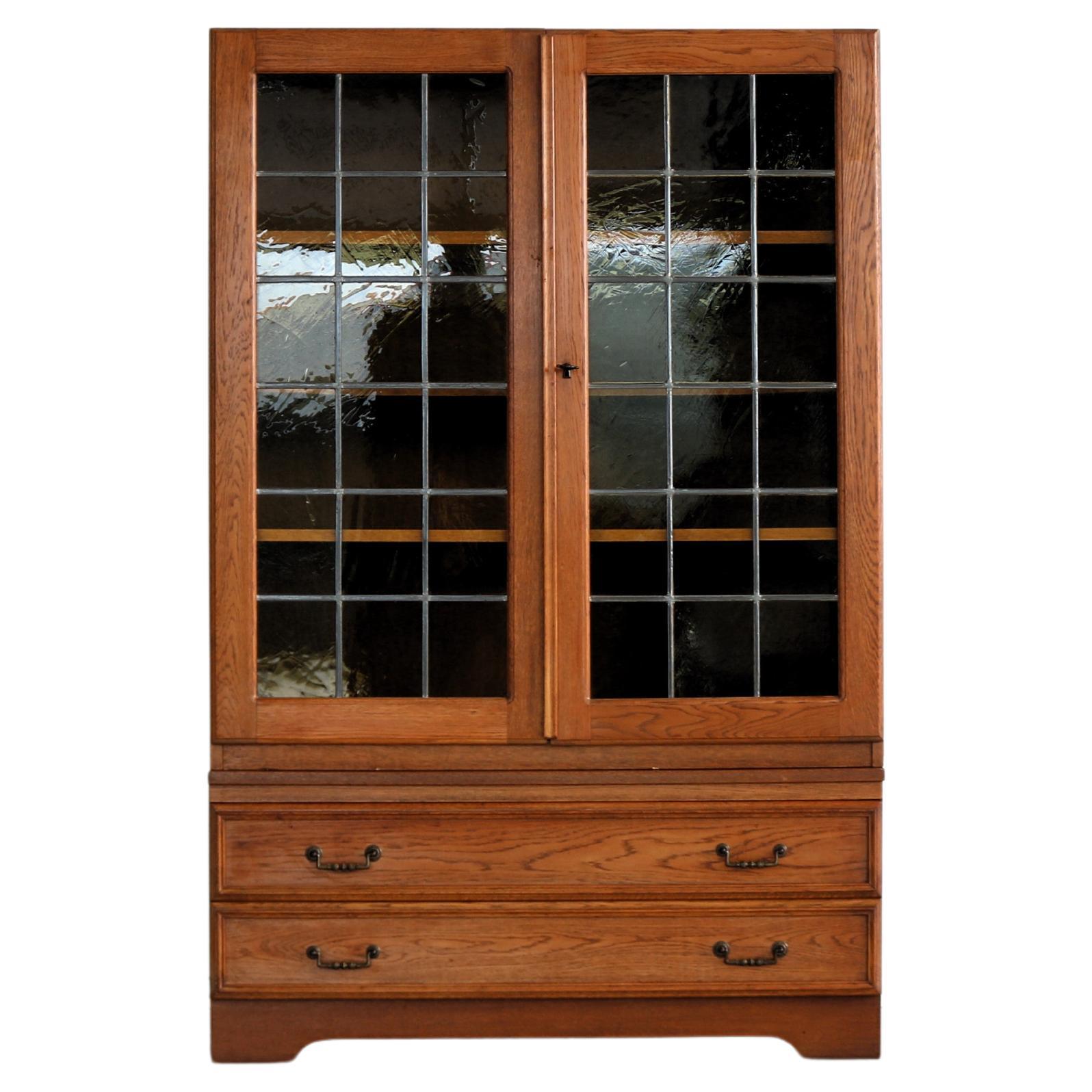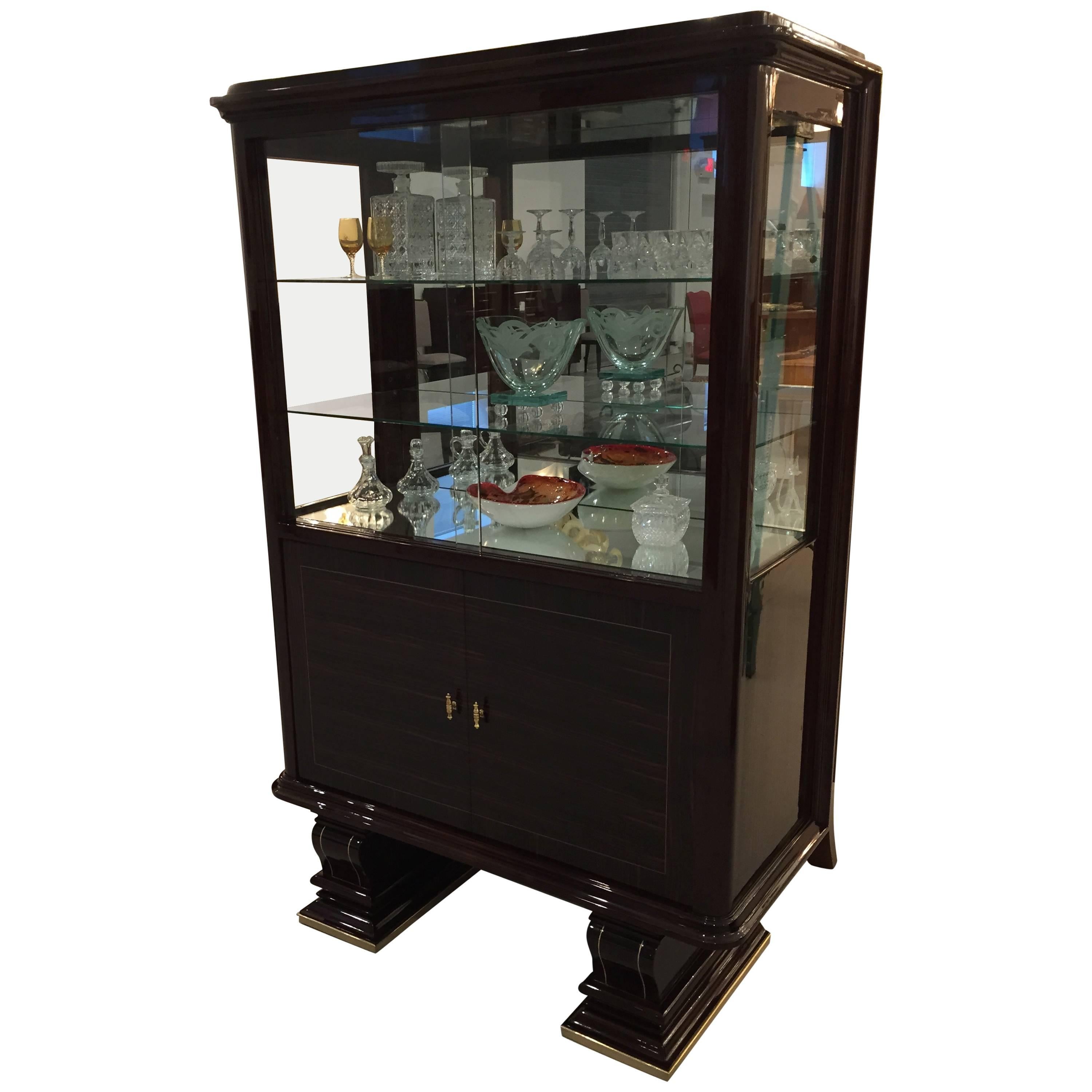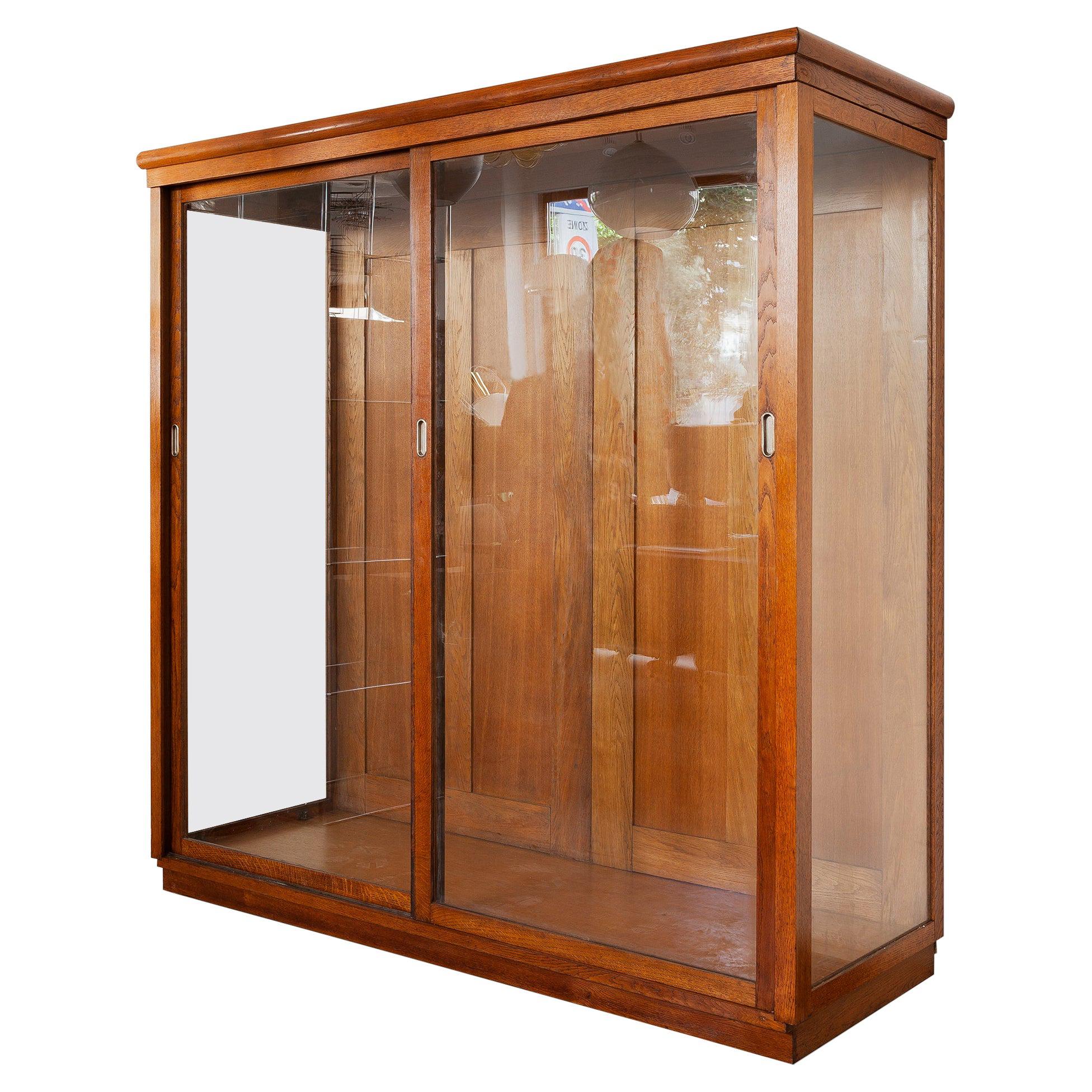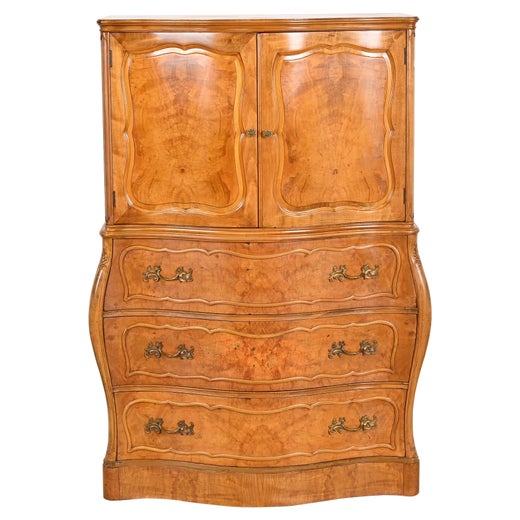Art Deco Signed Wolfgang Hoffmann for Romweber World's Fair Display Cabinet
About the Item
- Creator:Wolfgang Hoffmann (Designer),Romweber Furniture Co. (Cabinetmaker)
- Dimensions:Height: 66.75 in (169.55 cm)Width: 47.5 in (120.65 cm)Depth: 19.5 in (49.53 cm)
- Style:Art Deco (Of the Period)
- Materials and Techniques:
- Place of Origin:
- Period:
- Date of Manufacture:circa 1933-1936
- Condition:Wear consistent with age and use. In overall great condition, with losses and damage to left side of wooden pull of bottom drawer. Wear consistent with age and use. Delivered cleaned, waxed, ready for immediate use and generational enjoyment!
- Seller Location:Forney, TX
- Reference Number:1stDibs: LU5977234499292
Romweber Furniture Co.
Some vintage Romweber Furniture Company designs may strike the young as passé. But for fans of a certain age, the American brand never went out of style.
The Romweber story began in the late 1800s, with the launch of American Furniture Company, which made bedroom furniture, Batesville Cabinet Company, a dining-room-set manufacturer, and Batesville Coffin Company. The three companies eventually merged to become a large and reputable manufacturer of case goods, furniture and more. Not unlike many American companies, production at Romweber suffered during the Great Depression. The brand managed to stay afloat by making a rather strange pivot — to selling five-pound fruitcake boxes. During the Second World War, Romweber pivoted again, this time to the production of ammunition boxes and pontoons for American troops and, naturally, furniture for officers’ quarters.
While Romweber furniture (spelled “RomWeber” in vintage advertisements), dating back to the early 20th century, had designers working in the French Rococo and Chippendale styles, the brand is best known for its mid-century modern pieces. In the postwar years, Romweber manufactured walnut case pieces and storage cabinets that featured decorative olive-ash and burl-wood inlays with brass hardware as well as solid oak credenzas and dining tables designed by the likes of Harold Schwartz. For collectors of sophisticated 1950s furniture, the company’s sturdy Viking Oak line is particularly popular.
“It’s not uncommon for customers to say, ‘My parents had this Romweber Viking set,’” says Adam Cramer of collectors who visit Liberty & 33rd, the gallery he owns with his wife in South Bend, Indiana, about three hours north of Romweber’s birthplace in small-town Batesville. “It’s solid oak,” Cramer tells 1stDibs of the line of tables, chairs, desks and more.
Solid oak is the product of slow-growing deciduous trees. Solid oak furniture is durable, desirable and an investment that is usually associated with a hefty price. In solid oak furnishings, such as those that make up the covetable Romweber Viking Oak line, which launched in 1935, there aren’t any scraps of other components in the construction. Inspired by Scandinavian folk design, Romweber’s Viking Oak is said to have enjoyed one of the longest runs for a commercial furniture line in history. The collection went out of production in the late 1980s, and mid-century editions remain highly prized for their exceptional quality and hand-carved details.
Find vintage Romweber furniture on 1stDibs.
- ShippingRetrieving quote...Ships From: Forney, TX
- Return PolicyA return for this item may be initiated within 7 days of delivery.
- Art Deco Wolfgang Hoffmann Romweber World's Fair Century of Progress SideboardBy Wolfgang Hoffmann, Romweber Furniture Co.Located in Forney, TXA rare and important American Art Deco Century of Progress Sideboard by iconic designer Wolfgang Hoffmann (Austrian, 1900-1969) for Romweber Company, Batesville, Indiana. circa 1933-1936 Created for the 1933 Chicago World's Fair, fine quality craftsmanship and construction, having a rectangular exotic rosewood veneered top over conforming solid wood case fitted with four drawers affixed with horizontal pulls, the top drawer opening to reveal felt lined divided interior for silverware, flanked by cabinet doors opening to shelved interior, subtle geometric lines add interest. Rosewood, mahogany, richly figured blonde - golden birch or primavera. Signed, top drawer interior, featuring 1933 World's Fair mark impressed. **Please note, at the time of writing this, a matching display case - vitrine cabinet (shown in last photo) is currently available separately** Provenance / Acquisition: Property from the important and iconic Collection of Mr. James I. Rafftesaeth Jr., Dallas, Texas Acquired from highly reputable auction house, Heritage Auctions, Dallas, Texas. 2022 Design Signature Auction catalog #8091 History: Wolfgang Hoffmann was born in Vienna, Austria in 1900. He is the son of famous architect, pedagogue and Wiener Werkstatte cofounder, Joseph Hoffmann (1870-1956). Early on, following his father’s s interests, he was trained in the decorative arts and design. Wolfgang Hoffmann once reminisced, “I spent eight years at the Realschule, then three years went to a special architectural school, where I perfected my technical knowledge of architecture and general construction. From this school, I was graduated to the Kunstgewerbeschule [Studying under Oskar Strnad and Josef Frank in Vienna]. After finishing this school, I had one and a half years of practical in a well known architect’s office. Thereafter I worked in my Father’s office for two years”. Hoffmann met his future wife, Polish immigrant Pola (1902-1984) when they were both studying at the Kunstgewerbeschule. Joseph Urban (1872-1933) was needing an assistant for his architectural business in New York and contacted his friend and colleague, Joseph Hoffmann in Vienna. Hoffmann recommended his son Wolfgang. Urban hired him and sent a first class passage ticket to Vienna for Wolfgang to travel to New York. Wolfgang married Pola and traded his ticket for two tickets to America in steerage, arriving in New York City in December of 1925. Leaving the Urban office after nine months, Wolfgang and Pola formed an independent design practice with offices on Madison Avenue in Manhattan with the purpose of creating contemporary interiors and industrial designs. Early work included theaters, stores, and apartments mostly in New York City. During the late 1920’s and early 1930’s the Hoffmanns designed custom furniture for private clients. Some of these examples were shown in the February 1929 issue of House and Garden. Curiously, the examples’ design was attributed to Urban and the production to Pola Hoffmann, Inc. Established in the fall of 1928, the American Designers’ Gallery was “devoted exclusively to showing objects and interiors for practical use… by fourteen American architects and designers”. Its members included the Hoffmans and Urban as well as ceramist Henry Varnum Poor (1888-1971), architect Raymond Hood (1881-1934), artist designer Winold Reiss (1886-1953), graphic designer Lucien Bernhard (1896-1981), decorator Donald Deskey (1894-1989), and architect Ely Jacques Kahn (1884-1972). The Hoffmanns’ work was included in the American Designers’ Gallery’s two showcase events, its 1928 and 1929 exhibitions. Their dining alcove at the 1929 event featured a bench with a dinette table and two chairs in American walnut designed by Wolfgang and a rug by Pola. Lucien Bernhard, fellow Austrian immigrant who settled in New York a year before the Hoffmanns, operated the gallery and decorating service Contempora with Munich resident Bruno Paul (1874-1968). The Hoffmanns, occasionally participating with Contempora, designed a number of outstanding interiors, including the constructivist living room of 1930 for Mrs. O.R. Sommerich at 40 East 66th street. In 1934, Donald Deskey commissioned Wolfgang to design birchwood furnishings for the eclectic apartment at 625 Park Avenue belonging to Helena Rubinstein. In 1931, Wolfgang exhibited his work at the Pennsylvania Art Museum and the Museum of Modern Art in New York City. The same year, with Kem Weber (1889-1963) he organized the second and final exhibition of AUDAC- “Modern Industrial and Decorative Arts”- at the Brooklyn Museum. At this event, the Hoffmanns showed the dining room previously included in the American Designer’s Gallery’s 1929 exhibition in the Chase Bank Building lobby at 145 West 57th Street in Manhattan. In 1932 Wolfgang was asked to assist Urban in developing the color scheme for the 1933-34 Chicago World’s Fair “A Century of Progress”. He was also commissioned to design the interior and furniture for the fair’s lumber industries house. There he executed its living and dining rooms furnished by Kroehler Manufacturing Company of Chicago; the boys’ room by Shower Brothers...Category
Early 20th Century American Art Deco Sideboards
MaterialsBirch, Mahogany, Rosewood
- Maison Krieger French Louis XVI Matched Kingwood Glass Display Cabinet VitrineBy Maison KriegerLocated in Forney, TXA very fine quality French Louis XVI style gilt bronze ormolu mounted matched kingwood display cabinet / vitrine by the luxurious Parisian furniture maker Maison Krieger (1826-1910) ...Category
Early 20th Century French Louis XVI Vitrines
MaterialsBronze
- 19th Century French Gilded Porcelain Jewelry Cabinet, Manner of Martin CarlinBy Martin CarlinLocated in Forney, TXA magnificent Neo-classical 19th century Louis XVI taste giltwood royal jewelry cabinet, in the manner Parisian ébéniste Martin Carlin (b.1730–1785). ...Category
Antique 19th Century Neoclassical Cabinets
MaterialsPorcelain, Giltwood
- Industrial Art Deco Round Retail Store Display TableLocated in Forney, TXA fabulous Art Deco era industrial department store round display table. circa 1930s Having a circular top with metal rim, rising on wooden pede...Category
Mid-20th Century Industrial Industrial and Work Tables
MaterialsWood, Paint
- Antique American Art Deco Early Frigidaire Metal Advertising SignLocated in Forney, TXA scarce, likely one-of-a-kind, antique American Frigidaire enameled metal advertising sign, early 20th century, period Art Deco styling, the sign reads: "See Arkadelphia Hardware Co...Category
Early 20th Century American Art Deco Signs
MaterialsMetal, Enamel
- Breitling Retail Store Display Advertising SignBy BreitlingLocated in Forney, TXA scarce vintage Breitling watch three-dimensional retail store advertising display stand window sign. Rare large free-standing example, only given to select dealers, featuring a tall rectangular solid wood frame, raised chrome Breitling letters, over a yellow jet plane in sculptural relief form, on a most distinctive artistically distressed background; the reverse finished with a flueele fabric and adorned with the Breitling 1884 logo; rising on metal feet. Dimensions: (approx) 29.5" High, 24.5" Wide, 5.5" Deep Condition Report: Great original unrestored vintage condition. Presents well. Some condition issues/retaining vintage character marks and charm, including scattered nicks, mainly to the front top right frame, minor scuffs to the letters, scratches, slight bend to left foot pad, all typical wear consistent with age and indicative of industrial use. At the time of writing this, we also have some other luxury watch store signage / merchandising displays, including Rolex, Panerai, Cartier, antique clock...Category
Late 20th Century Industrial Signs
MaterialsMetal, Chrome
- French Art Deco Vitrine, Display CabinetLocated in North Bergen, NJThis incredible French Art Deco vitrine has a large glass front with glass shelves inside. Gold hardware to accent the wood beautifully. Can be...Category
Vintage 1930s Art Deco Vitrines
- art deco display cabinet sideboard 1950sLocated in GRONINGEN, NLart deco display cabinet sideboard 1950s period 1950s design unknown condition good light signs of use size 154 x 100 x 46 (hxwxd) details oak; lead; glass; article number...Category
Vintage 1950s Dutch Art Deco Vitrines
MaterialsGlass, Oak
- French Art Deco Vitrine, Display Cabinet / Dry BarLocated in North Bergen, NJThis French Art Deco vitrine with faux ivory trim has been professionally refinished by a third generation restorer. Having glass sliding doors with glass shelves. Cabinet doors open...Category
Vintage 1930s French Art Deco Vitrines
MaterialsWood
- Cadbury’s Art Deco Display Cabinet, Art Deco Crome This small but CharmingLocated in Chillerton, Isle of WightCadbury’s Art Deco Display Cabinet, Art Deco Crome This a small but Charming Cadbury’s Sweet Shop Display Cabinet it is a counter top piece, from above you can see it is in the shap...Category
Vintage 1920s Art Deco Vitrines
MaterialsChrome
- Art Deco Vitrine Display Cabinet a Cabinet of Curiosities, Wardrobe or ShowcaseLocated in Antwerp, BEA beautiful Art Deco display cabinet from a former Haute Couture Dress store, suitable for hanging long dresses or coats also very effective for exhibiting...Category
Vintage 1920s Dutch Art Deco Vitrines
MaterialsOak
- Jules Leleu Modernist Dry Bar Cabinet, French Art Deco Display CabinetBy Jules LeleuLocated in Miami, FLFrench Art Deco Dry Bar Cabinet, Elegance Attributed to Jules Leleu This captivating French Art Deco display cabinet, attributed to the renowned designer Jules Leleu, embodies the ...Category
Early 20th Century French Art Deco Vitrines
MaterialsBrass
